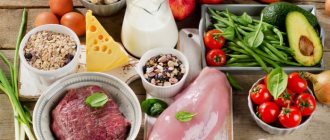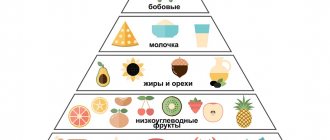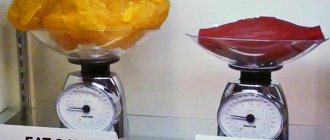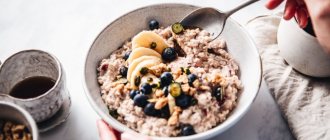Onward to gaining muscle mass without unwanted fat! To do this, we’ll figure out how to determine the required daily amount of calories and consider an approximate nutrition plan.
The process of muscle growth does not only come down to the number of circles, repetitions, consistent and progressive loading. In addition to all this, in order to build muscle mass, you need to adhere to a certain nutritional plan. Pulling iron without proper fork function is akin to climbing uphill through mud. It might be possible to reach the top, but it will take a hell of a lot of time.
There is a popular mantra in the sports community that nutrition is 90% (or 80%, or 70%) of success. This attitude diminishes the importance of proper training. The bottom line is that both nutrition and training are equally important. These are not 2 separate variables that add up to 100%.
Training is 100%. And the food is also 100%. When both of these vital components are successfully implemented, maximum progress is achieved. If you train 100%, but eat only 50%, or vice versa, then it will simply be a waste of time.
This article assumes that you already have an understanding of how to train properly, so we will focus on how to gain lean muscle mass without fat for men purely from a nutritional standpoint.
The need for a bulking diet to build muscle
To maintain current weight, each person needs a certain number of calories. This value is known as the “daily calorie requirement.” In bodybuilding, consuming more calories than the daily requirement is considered a bulking diet.
Providing the body with additional raw materials:
- Helps the body better restore muscle fibers damaged during lifting weights.
- Immerses the body into deeper anabolism; When the body no longer has the need to strictly ration caloric expenditure solely to ensure vital physiological processes, it can more freely spend resources to cover the consequences of strength training.
It is logical that the lower the number of calories eaten, the less likely it is that the body will spend these resources on non-primary goals such as muscle growth. The body is too busy maintaining organ function and recovering from daily wear and tear.
During periods of excess calorie consumption, the body is much more willing to build muscle tissue. Body weight also increases with the right diet, most of it being muscle weight. Conversely, during a limited calorie intake, the process of muscle growth slows down or even stops - it’s simple - the body at this moment has more pressing tasks.
The conclusion suggests itself...the higher the consumption, the higher the chance of achieving maximum muscle growth. But, before you run to the refrigerator and stuff everything you find in it, let’s pay attention to another important factor for muscle gain: the physiological limit of muscle growth.
The body can only gain a certain amount of muscle in a year. If you depict the dynamics of this indicator in the form of a graph, it will be very similar to the half-life curve. In each subsequent training year, the potential amount of muscle that a person can pump up, or rather the body can build, is reduced by half. Here is a standard dynamics (under ideal conditions) of how much meat you can gain, which you can use as a guide for setting your goals.
- 1st year – expected muscle gain of up to 7.3 kg.
- 2nd year - expected muscle gain of up to 3.6 kg.
- 3rd year - expected muscle gain of up to 1.8 kg.
- 4th year - expected muscle gain of up to 0.9 kg.
- 5th year - expected muscle gain of up to 0.5 kg.
It is quite obvious that if you ignore these indicators and rapidly gain weight, then most of it will be fat. Slow, controlled weight gain is the strategy you should follow to get pumped up and get quality muscle growth.
Mass gain program for endomorph girls
The main problem of people of this type is excess weight. In your case, I would recommend a different plan! First lose weight, and only then build muscle.
Nutrition tips
- Endomorphs should not rely on carbohydrates, as most of them will be stored in fat reserves. Stick to a B/F/U ratio of 40/30/30 for muscle gain and 50/30/20 for fat loss.
- Eat more greens and vegetables; they are low in calories, but at the same time suppress hunger and improve digestion.
- Try not to eat carbohydrates in the evening.
- During the period of weight gain, the calorie surplus should be minimal (no more than 300 kcal).
- When losing weight, use the scale arrow as an indicator of progress, and when gaining weight, use your waist size as an indicator of progress.
Training Tips
- Unlike ectomorphs, you need cardio! It will increase calorie expenditure and prevent fat gain. Cardio 2-3 times a week should be your rule.
- Also use the fullbody scheme as a training complex.
- Give preference to basic exercises.
- Alternate between high-rep (12-15 reps) and strength (8-12 reps) training. The training time can be increased to 1.5 hours, and cardio can be added at the end of the workout.
Different types of diets for weight
Believe it or not, there are several different techniques. Here they are:
- Lean building is an eating plan aimed at gaining lean muscle mass with a minimum amount of fat. Macronutrient intake is carefully monitored.
- Dirty rocking is a more aggressive eating option that consumes more calories, a significant portion of which comes from “dirty” or processed food/fast food. With this approach to nutrition, calories and macronutrients are rarely controlled.
- Flexible Nutrition ( IIFYM ) – This approach can be used for both weight gain and weight loss. The main emphasis is on gaining the desired amount of macronutrients, without paying close attention to the food that is their source.
- Clean training is not much different from dry training, except that greater emphasis is placed on eating non-processed foods (convenience foods, fast food, etc.). The main emphasis is on how to gain clean muscle mass using proper nutrition with natural products.
In this article, we will not evaluate the usefulness of these techniques. Our goal first and foremost is to create an eating plan that is primarily based on lean and clean building. You can adjust this sample meal plan to suit your personal needs.
But without hard work in the gym, the body will have no reason to process those excess calories and turn them into additional muscle tissue.
How to eat while gaining muscle mass? Practical advice
The hormone insulin controls the deposition of fat in the body. It is secreted by the pancreas in response to food intake. Moreover, in direct dependence - the more you eat, the more insulin you have in your blood. And further: the more fat you have under your skin. Well, now tense your head. How to limit insulin secretion? That's right, you need to eat less! Yes, this is exactly the advice that fashion magazines give to their readers, but on such a diet a bodybuilder will stretch his legs in just a week. The answer you need sounds like this: eat little, but often! As a result, you will get a lot of calories without the threat of an insulin meltdown.
So, remember the first rule: a bodybuilder eats 6 times a day. Look, someone has already torn his hat off his head and is trampling it underfoot! Like, this is simply impossible! What about the family? Job? Live to eat?!
Food is pleasure just like sex. Against the backdrop of hard training, it becomes doubly enjoyable. So, by multiplying the number of meals, bodybuilding only increases the degree of pleasure in your life. But seriously, organizing frequent meals is perhaps the most troublesome aspect of sports. It requires strict discipline and the ability to plan. If you don’t have any trace of anything like that, grit your teeth and take on self-education.
Believe me, not only the size of your biceps, but also your entire success in life depends on these character traits. Organizing frequent meals is only one test of strength, and it’s far from the toughest.
And now about the second rule. Insulin secretion is influenced by food composition. Carbohydrates are especially active in this regard. For this reason, they can be taken no more than 40-80 grams at a time. In this case, the specific serving size depends on your natural dimensions. The upper limit is for especially large guys who already weigh over one hundred kg.
You only need 5-10 g of fat (per single dose) and 40-60 g of protein. The secret is that our digestion perfectly absorbs nutrients only if the “correct” ratio of proteins, fats and carbohydrates in a dish is present. An attempt to go beyond the boundaries of these numbers is fraught not only with excess fat, but also with a stop in muscle growth. In fact, muscle nutrition will worsen.
The mistake of the old days is that the bodybuilder consumed a lot of calories all day long. But if you want to grow muscle instead of fat, you can only eat a lot three times: in the morning, at breakfast, and after training. Or in even portions, six times a day. The main condition is to set the required amount of calories. Also, it is advisable to consume carbohydrates in the first half of the day, and take protein foods in the second half of the day.
At night, the body only spent energy, and in the morning it desperately needs to be replenished. For this reason, breakfast should be high in calories. And then everything will be absorbed without leaving a trace. The breakfast example is quite simple. For example, when you wake up in the morning, it would be good to immediately drink a protein shake consisting of whey protein. It is quickly absorbed and replenishes the body's need for protein. If there is no protein, we immediately start cooking or heating the food. An excellent breakfast would be buckwheat with a light, low-fat salad. By the way, the salad can be seasoned with flaxseed or olive oil. It is better not to eat meat in the morning and give preference to cereals that contain slow carbohydrates, which the body needs to absorb protein and provide the body with energy.
The situation is somewhat different after training. The muscles are extremely exhausted and need nutrition, and therefore the subsequent meal should be especially rich in calories. Moreover, restrictions on carbohydrate intake are lifted. They can be taken twice as much as the known norm - up to 180 g. Moreover, without the risk of fat deposits. Yes, carbohydrates will cause insulin secretion, but after training it “forgets” about fat and acts as a transport hormone. Insulin “carries” carbohydrates and sugar on itself, and actively nourishes muscle cells with them.
The remaining meals contain a relatively modest number of calories, however, taking into account the abundant breakfast and the heavy load of proteins and carbohydrates after training, the daily calorie intake will be record high.
Let's summarize
To add lean muscle mass, you only need to eat a lot twice a day - at breakfast and after training. The rest of the day, the rule you already know “eat little, but often” applies.
Another mistake of the past was that the bodybuilder ate the same amount on rest days. Having set a high carbohydrate intake for themselves, the athletes continued to consume it during the recovery period. The energy consumption of rest is incomparably lower, and therefore excess carbohydrates became absolutely unnecessary. Here insulin came to the rescue and converted excess sugar into fat.
But if only this! The fact is that in the evening insulin increases its activity. So a large amount of carbohydrates in evening meals became doubly fatal.
According to sports science, protein intake should remain consistently high: up to 4 grams per kilogram of body weight on training and rest days. This means that reducing the proportion of carbohydrates in the diet will entail a major reduction in the calorie content of the daily diet. If on training days there are 36-40 calories per kilogram of body weight, then the recovery period requires reducing this figure to 24-28 calories. And this is the last rule of “proper” nutrition. You will have to vary the calorie content of your daily menu every now and then, and this will become a reliable guarantee of the growth of “lean” muscles.
Determining calorie needs
Before you begin directly drawing up a nutrition plan, you need to determine your daily calorie needs. This is the number of calories that you need to eat so that your current weight remains unchanged. You can calculate this value using special online calculators. After the program receives information about your height, weight, age, gender and physical activity level, it calculates the approximate number of calories needed to maintain the specified weight.
However, calorie counting tools are just a starting point. Depending on the scale readings, some adjustments will need to be made periodically.
However, we advise you not to pay attention to changes in weight during the first 2 weeks. Increased calorie intake can cause additional water retention in the body. This weight gain is not due to fat and should not be a reason for immediate dietary changes at the very beginning of the diet.
After a couple of weeks, you can adjust anything if necessary.
We build from the basics
It's amazing how many people go to the gym and at the same time stagnate, without improving their health or physical fitness. Even more surprising is how many articles and magazines are now being published offering unique new programs and secret trainings and promising quick results. You've probably all seen a guy in the hall with a page with a program torn out of a magazine. As a result, people forget about the basics and therefore do not move, or maybe society is simply focused on quick results and is not ready to work long and hard.
Making a meal plan
After determining your daily calorie needs, you can move on to creating a nutrition plan. This will require the following steps:
- Step 1 – Add another 300 kcal to the resulting amount. This figure will be our starting point.
- Step 2 – Based on the table below, calculate your daily protein requirement. Also calculate how many calories in your diet will come from this amount of protein. To do this, multiply the resulting value (in g) by 4. Thus, if the daily value is 180 g of protein, then the number of calories they contain will be 720 kcal (180 × 4).
- Step 3 – Multiply your daily calorie intake by 30%. This value will show how many calories from fat should enter your body daily. Depending on your preferences, you can reduce or increase this figure by 5%.
- Step 4 – Calculate your daily carbohydrate intake. To do this, subtract the amount of calories from protein and fat from your total daily caloric intake calculated for muscle building. Thus, with a height of 178 cm and an increased daily calorie intake of 3,000 kcal, 900 kcal will come from fats (30%), and 800 kcal from proteins. This means that 1,300 kcal/day remains for carbohydrates. There are 4 kcal per 1 g of carbohydrates, therefore 1,300 kcal is equivalent to 325 g of carbohydrates.
| Daily protein intake | |
| Height | Proteins, g/day |
| 157 cm | 160 g |
| 160 cm | 165 g |
| 162 cm | 170 g |
| 165 cm | 175 g |
| 168 cm | 180 g |
| 170 cm | 185 g |
| 173 cm | 190 g |
| 176 cm | 195 g |
| 178 cm | 200 g |
| 180 cm | 205 g |
| 183 cm | 210 g |
| 185 cm | 215 g |
| 188 cm | 220 g |
| 191 cm | 225 g |
| 193 cm | 230 g |
Note: Protein intake is based on a person's height. The higher the height, the greater the initial muscle mass. According to a general empirical rule, every 2.5 cm of height is responsible for approximately 1.8-2.3 kg of muscle.
As a general rule of thumb, it is recommended to consume 1g of protein for every 450g of body weight, we suggest increasing this to 5g for every 2.5cm of height.
With a surplus of calories, the body will be much more willing to form new fibers. Weight will increase even with the right approach, mainly due to muscle gain.
Rule 3: Share the load
Most calisthenics exercises involve all muscle groups at the same time. This is great if you just want to tone up and build functional strength, but it can get in the way if your goal is to build muscle.
In order for muscles to grow, you need to load them better. Workouts targeting specific muscle groups or bodybuilding splits are good for this.
Here are two classic splits:
- Upper body/lower body.
- Push-ups/pull-ups/legs.
If you use the first split, everything is simple: when you train your legs, you rest your arms, and vice versa. In the second classic split, you train your chest and triceps separately on push-up day, your back and biceps on pull-up day, and your legs on day three. During this time, your muscles will have time to recover.
“Too much” protein?
Some might argue that athletes can get by with less protein. This opinion has a right to exist, but here are the reasons for a slight increase in daily protein intake:
- Nutrition balance . A special diet is not only about the minimum amount of protein (g/day) required for stable growth. During muscle building, more calories are consumed than under normal conditions. And it’s better if the diet is balanced and contains a little more protein instead of a lot of carbohydrates.
- Eating according to your weight gain goal . If the goal is to build muscle, then you need to eat accordingly. You can consider this an experienced tale, but if you are striving for muscle growth of 77 kg, and now your weight is 68 kg, it is hard to believe in successfully achieving this goal with enough nutrition only for your current weight.
- Are you aiming for the minimum? Successful people don’t tend to ask themselves every day: “What is the minimum I need to accomplish today in order to achieve my goal?” If you really want to be among the minimalists, then for God’s sake. But objectively, it is better to leave some reserve in protein consumption and “overeat” a little rather than “undereat.”
Rule 5: Be creative with classics
Danny Kavadlo was once approached by a young workout artist, Alex Ceban. He was a true purist in calisthenics training and trained for his first bodybuilding competition using solely his body weight.
Alex could do anything from one-arm push-ups to one-leg squats, but he lacked knowledge about isolation training. He turned to Kavadlo to find out the most effective bodyweight exercises to target his trapezius.
Danny Kavadlo advised him to do a modified version of handstand push-ups. To use the trapezoid more, he suggested placing your hands on high supports. This helped increase the range of motion and shift the load from the deltoids to the trapezius. He also recommended pull-ups with a wide grip behind the head.
Using only his body weight, Alex trained for the competition and took first place at the WNBF Amateur Men's Physique.
Alex Ceban - in the center / alexceban.com
As you can see, training with your own weight is quite enough to unlock the potential of your body. Stay creative and you can always target the right muscle groups more.
Calculation example for a weight diet
Before we move on, let's do some calculations based on a specific example. Let's take a 173 cm tall person who needs to eat 2,700 kcal/day to build lean muscle.
- Proteins - according to the table, the daily protein requirement is 190 g, which is equivalent to 760 kcal.
- Fats - multiplying the daily caloric intake of 2,700 kcal by 30% gives a fat requirement of 810 kcal/day, which is equivalent to 90 g of fat, since each gram contains 9 kcal.
- Carbohydrates - this leaves 1,130 kcal/day, which is equivalent to 282.5 g of carbohydrates.
Step 1. Analyze your physical form
Haven't you looked in the mirror in a while? It's time to do it. Take a closer look, if you are able to see the abs or they are hidden by a small layer of subcutaneous fat, then feel free to take the second step. If, after pinching a fold on your stomach or thigh, you see that it is as thick as your thumb, then do not rush to follow the chosen path. First, you will have to lose excess fat “ballast”.
Nutrition structuring
Now that we have estimates of our daily macronutrient needs, it's time to start structuring our diet. You can determine the number of meals according to your preferences. The most important thing is to get the required amount of calories and macronutrients.
Some sources recommend limiting yourself to 1-2 meals per day. Others, from more classic bodybuilding sources, suggest a frequency of 7, 8 or even 9 meals. We, in turn, strongly recommend building your diet based on already established eating habits.
- Night raids on the refrigerator . If you like to eat heavily in the late evening, then leave most of your calories for evening meals.
- Frequent snacking . If you are a snacker, eat smaller, more frequent meals throughout the day.
- Breakfast haters . Hate big breakfasts? No problem. Eat small meals before lunch, but fill your plate well at subsequent meals.
Few people like to fill their stomachs immediately before training, as this leads to a feeling of sluggishness and a bloated stomach. Plus, it's incredibly cool to have a nice snack after a workout. That’s why the meal preceding your workout at 5 p.m. consists primarily of protein to keep you feeling light until you leave the gym.
It may take some time to better understand nutritional patterns, but don't give up. Swap meals, calories, and macronutrients to suit your personal needs.
Also, don’t let anyone lead you astray from your chosen path. Among bodybuilders there will probably be advisors who know exactly how you need to eat. But your meal plan should ALWAYS be based on YOUR eating habits. Without any exceptions.
The following is an example of a diet based on 3,000 kcal/day.
Sports nutrition for gaining lean mass
- Whey protein (isolate) is a purified supplement, has virtually no sugar, and 2 servings per day will replace meals and replenish with quality protein after muscle breakdown during exercise. Read more about whey protein →
- Amino acids are builders of new muscles. The growth of dry mass is impossible without amino acids, especially BCAA, which are not produced by the body. You need two servings of BCAAs per day, one serving on an empty stomach, the second immediately after training. Full cycle amino acids also 2 servings, one before training 30 minutes, the second at night.
Example of a 3,000 kcal diet - Table
| Dry mass gain without fat | |
| Eating | 3000 kcal |
| № 1 – 7:00 | 2 tbsp. cooked oatmeal, protein shake, fish oil 462 kcal, Proteins/Carbohydrates/Fats = 34.9/59.1/9.6 |
| № 2 – 10:00 | Medium banana, 4 boiled eggs 415 kcal, used/U/F = 26.3/28.6/21.5 |
| № 3 – 13:00 | 2 medium potatoes, 115 g chicken breast 405 kcal, used/U/F = 32.9/66.4/6.2 |
| № 4 — 15:30 | Protein shake, 30 g almonds, 6 strawberries, 12 grapes 348 kcal, used/U/F = 29.9/24.6/16 |
| Training – 17:00 | — |
| № 5 – 19:00 | 170 g ground beef (80% lean), 2 tbsp. boiled rice, 115 g salsa, 230 g vegetables of your choice 985 kcal, used/U/F = 57.7/114.7/30.9 |
| № 6 — 21:30 | Casein shake, fish oil, 2 rice cakes, 1.5 tbsp. l. peanut butter 381 kcal, used/f = 28/23.7/15.1 |
| Total | 2996 kcal, used/U/F = 209.7/317.1/99.3 |
Diet adjustments
It is worth understanding that the initial calculation of calorie intake is just a starting point. It is necessary to monitor the scale readings and make appropriate adjustments to your diet. Here are some key control points.
1-2 Week Diet
Don't panic if you gain a few extra pounds in the first few weeks. This is a natural reaction of the body to an increase in incoming food and this excess is explained by the weight of additionally retained water. Additional food involves increased carbohydrate intake.
Carbohydrates retain additional water in the body and can easily lead to a noticeable deviation of the scale needle. This weight gain occurs entirely from water and not from fat. This fact deserves special attention.
At this point, you don't need to change anything about your calorie intake. Use the first few weeks to develop the habit of eating this way.
3-6 Week Diet
Starting from the 3rd week, it is time to determine your baseline level. If you are new to gaining weight, then during the first year of training your muscle gain may be a little more than 0.5 kg/month. Therefore, beginners should aim for a maximum of 700-900 g/month.
If the weight gain is more than 900 g/month, then it’s time to make adjustments. Reduce your daily caloric intake by 300 kcal and stick to this amount for the next month. If your weight continues to skyrocket, make further adjustments.
On the other hand, if in 3-6 weeks. the weight remains the same, you need to increase the amount of food consumed. Add 500 kcal to your daily diet and stick to this value for a month. After 4 weeks, adjust the value up or down as necessary.
Intermediate stage
If you have already gained 3.5-6.8 kg of muscle, then it would be wise to reduce your monthly weight gain. Advanced athletes with a weight gain of more than 450 g/month. risk gaining unwanted excess fat.
Advanced athletes who are actively gaining weight are in fact on a fat gain diet. And while the extra calories will provide impressive strength gains, they will not lead to additional muscle growth beyond what is expected.
Training programs and their variables
There are many variables that influence the effectiveness of a workout. The number of repetitions, sets, rest time between sets, the total volume of exercises (number of repetitions multiplied by the number of approaches) - all this affects which system in the body will be depleted and what the overall effect of the training will be. There are several main goals that can be achieved by strength training: increasing strength, increasing endurance, muscle hypertrophy. The goal you choose will dictate your training option. Since we're talking about the basics, here are some guidelines:
- Reps per set: from 6 to 15
- Approaches per exercise: 3-5
- Total approaches per muscle group: 8-20
- Rest time: 60-90 seconds
These are very general but workable principles suitable for beginners. At the same time, there are many programs with other numbers - less or more than those given here.
How long should the bulking phase be?
Proper adherence to such a nutrition program does not lead to a significant increase in adipose tissue. In the first year of training, you should aim to gain 5.5-7.3 kg of muscle and a maximum of 2.7-3.6 kg of fat. You can easily get rid of this amount of fat in just a month of high-quality “drying”.
Beginners should not interrupt their weight gain during the first year of training. Their muscles grow very quickly and there is no reason to slow down this process.
After the first year of training, it won't hurt to:
- Every 6-8 months, dry yourself for 1 month.
- Alternate 3 months of bulking, 1 month of cutting.
Read the guide on how to properly dry your body to increase muscle definition.
Any of these methods will help advanced athletes build a muscular physique and get rid of any excess fat gained during bulking diets.
Differences between female and male mass gain
In general terms, the rules for building muscle are the same for both sexes. This includes eating a balanced diet with a surplus (surplus) of calories, strength training with iron, and rest. But if you dig deeper, you will still see some differences, or better yet, nuances.
- Women are more resilient.
This is explained by the predominance of slow muscle fibers in the muscles. You need to perform the exercises with a high number of repetitions (10-20).
- The pain threshold of the weaker sex is lower.
Ladies may object, arguing that the man is unlikely to withstand childbirth. But that's not what we're talking about now. Your body, unlike a man’s, will in every possible way prevent you from bringing your muscles to failure (when you can no longer perform a repetition on your own). And this is normal, because this way it protects your more fragile ligaments from injury.
The conclusion from this is that failure training is not for you. Train until you feel good, but no more.
- Testosterone levels in the female body are lower.
By the way, this explains the low pain threshold. Testosterone is responsible for building muscles in our body, which is why it is more difficult for girls to build them. But you won’t be able to pump up and become like a man! And female bodybuilders are so huge only because they take steroids.
- Ladies should pay closer attention to their figure when gaining weight.
Since you are more likely to store fat in problem areas (buttocks, thighs, stomach and chest). Focus not on the scale, but on the size of your waist. If your waist grows too quickly, you are gaining fat, not muscle.
Men and women have common traits, such as body types. In fact, there are dozens of these types, but they are all combinations of the three main ones - ectomorph, endomorph, mesomorph. The method of gaining muscle mass depends on which type predominates in you.











